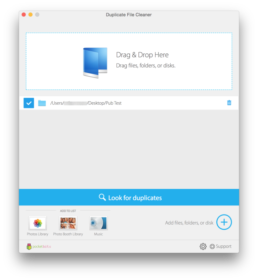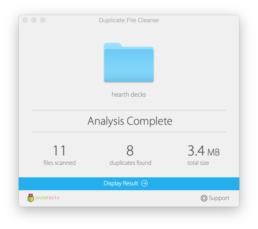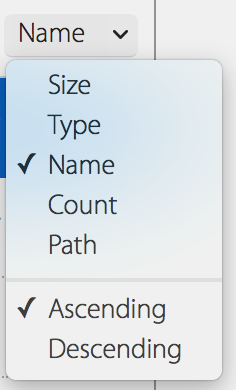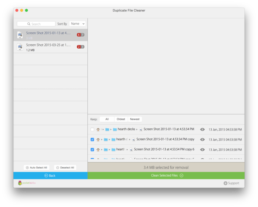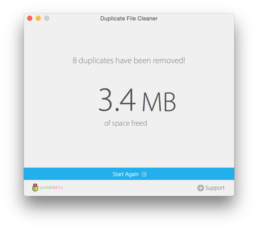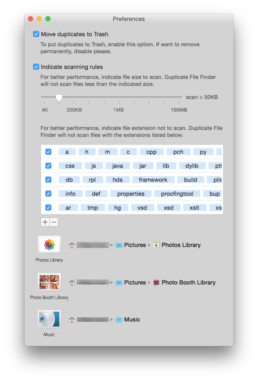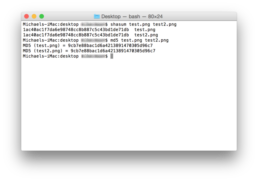User Guide
Duplicate File Cleaner uses a true SHA-1 checksum file compare to ACCURATELY find legitimate duplicates. This means that it finds all duplicate files by looking at the actual HASH value. So if the contents of the file are changed in anyway, then it is no longer a legitimate duplicate since the hash values are different. Renaming a file does not change the file contents, so Duplicate File Cleaner will still find all duplicates even if they are named differently.
Getting started is easy and painless. Just drag & drop any folder to find all your duplicates.
If you want to scan your iPhoto/Photos, Photo Booth, and Music Libraries for duplicates, add them to your list from the bottom left (*please remember to close Photos/iPhoto applications when scanning). Duplicate File Cleaner supports scanning multiple locations at once.
If it detects any duplicates, click “Display Result”.
In our example we have 8 duplicates. On the right navigation bar, we see that there are 2 different files. The first file has 7 copies. The second file has 3 copies. 10 total files. This gives us a total of 8 duplicates and 2 originals (10 total files).
Selecting “Auto Select All” will do all the work for you and automatically select all the copies and leave 1 original copy for you to keep.
In our example you will now see the 6 duplicates selected out of the 7 total copies for the first file. Second file has 2 duplicates selected out of the 3 total copies.
The bottom navigation window shows you the file details and location. Selecting any of these files will show you the preview up top. Click the “eye” icon to reveal the files in Finder and see exactly where those files are.
Press “Clean Selected Files” to remove all of your duplicates!
Congratulations, you’re done!
For advanced users, you can customize your scan settings under preferences. Located on the bottom right of the home screen or from the drop down menu on the top left.
Here you can choose to scan files only greater than a certain file size for faster/optimized scanning of large files. You can also put custom file extensions you do not wish to scan. You will see your Photos, Photo Booth, and Music library locations on the bottom.
Hope you enjoyed the tutorial. Let us know down below. 🙂
To check the SHA-1 and/or MD5 hash checksum of your files, navigate to your terminal. You can use the shortcut to open up spotlight and type “terminal”.
Once in termal you can type the syntax:
shasum /path/to/file
To verify a file named “test.png” and “test2.png” in the current folder we’re in, it would be:
shasum test.png test2.png
That long hexadecimal string is the SHA1 hash.
Similarly for MD5, you can type the same syntax:
md5 /path/to/file
To verify a file named “test.png” and “test2.png” in the current folder we’re in, it would be:
md5 test.png test2.png
In the above screenshot you can also see the MD5 example.
For more details on checking your hash, you can visit the following links.
http://osxdaily.com/2012/02/05/check-sha1-checksum-in-mac-os-x/
Please remember to close Photos/iPhoto applications when scanning. Run the scanner after you close the applications and it should work. 🙂
If you are on a network drive or external drive, files can only be permanently deleted because they do not have “.trash”. Remember to set settings to permanently delete under preferences/settings in the app for these drives.
Warning: They will be permanently deleted and NOT recoverable.
Duplicate File Cleaner uses a true SHA-1 checksum file compare to ACCURATELY find legitimate duplicates. This basically means that it finds all TRUE duplicate files by looking at the actual HASH value. Renaming a file with a different name doesn’t change this.
If the file contents are altered, then it is no longer a legitimate duplicate and Duplicate File Cleaner will not flag it as a duplicate.
If it is not detecting your images as duplicates, then they are not TRUE duplicates. They were altered. Duplicate File Cleaner only finds all legitimate duplicate files.
You can check your SHA1 and MD5 hash checksums to see if they are true duplicates:

